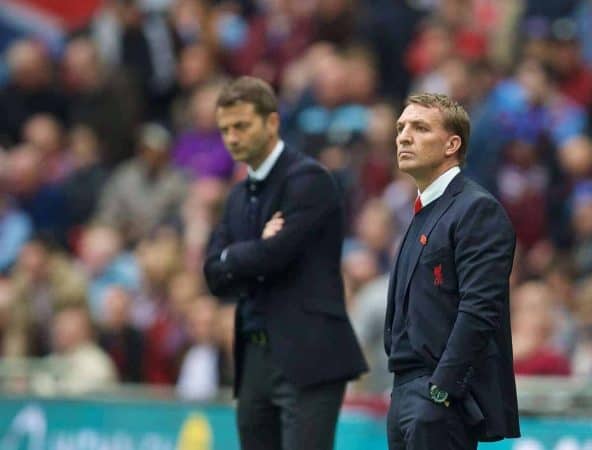Karl Matchett provides a tactical analysis of Liverpool’s FA Cup semi-final defeat to Aston Villa, with numerous problems apparent at Wembley on Sunday afternoon – not least the four different formations and use of Steven Gerrard.

“Starting a regular tactical analysis column just a few weeks before the end of the season is such a cop-out. Just a few games of easy street with not much to play for, then a summer of pointing to why the problems in those games mean X, Y and Z should be signed in the transfer window.”
The obvious assumption has to be that this was Brendan Rodgers’ big idea on the eve of the FA Cup semi-final for Liverpool against Aston Villa and, as such, he decided to fit an entire season’s worth of positional, formational and role changes into one single game, hence no less than four different systems used by the team at Wembley.
Unfortunately, none of the changes paid off for the Reds who were sluggish and second-best, and it’s Villa who will be returning to face Arsenal while Steven Gerrard shares out the birthday cake at home.
It started with a back-four shape at kick-off, with Emre Can sneakily and immediately slipping into his back three berth once a ball had actually been kicked. Such a minor mind-game is standard warfare nowadays, but it was a position the German was to return to in-game within half an hour or so of kick-off. The opening stages saw Liverpool in a 3-4-2-1, pressing Villa from around the halfway line in an apparent bid to stop them being able to get midfield runners in behind the Reds’ own midfield, a massive problem against this particular opposition over the past few seasons.
With much of Villa’s first-half attack coming down their left, it meant Emre Can was often the man to push up and close down the problematic youngster Jack Grealish, but it also left Liverpool without an out-ball when they did win back possession.

Given that a large portion of the opening 20 minutes took place down that flank — the far side, by camera-angle view — it meant that the rapid bursts forward from Alberto Moreno and the technical ingenuity from Philippe Coutinho were totally nullified. Whether this was by vague design from Villa or simply the way the match panned out, it wasn’t working for Liverpool and Brendan Rodgers was totally correct to attempt to switch things around.
Whatever it was the Reds had worked on in the week preceding Wembley to transition the ball from the centre of the park to the final third, it wasn’t happening.
It’s worth pointing out at this stage that tactics can only take the team so far. Desire, pace, application, the proper mentality and concentration are all just some of the factors which aid winning any particular match, and it was painfully evident throughout the 94 minutes that Liverpool were lacking in most of these areas when it mattered most. That said, the plan (or plans, as was the case) in place has to be to take advantage of areas where the opposition is weak and the Reds had failed to really do so in the early stages.
Dead on 20 minutes, Rodgers gave the shout. A back four was in, Lazar Markovic was to get further forward and Coutinho went wider on the left — it was a 4-2-3-1, not a system the Reds had much success with earlier in the campaign, but one which can help close down spaces in midfield and try to get more players running ahead of the ball than the team had managed so far.

Initially it worked well. Aston Villa had a reshuffle of their own to tend to after an injury to Nathan Baker, and some rather more direct passing saw Liverpool have three, and then five, players inside or just outside the penalty box in two successive attacks. Around that point, the 27th minute or so, was really the only time (until the final five minutes when everything was launched forward) that there was a sense of Liverpool being on top in the game, that possession and numbers were beginning to tell.

It led to Coutinho’s goal a few minutes later, but that was as good as it got for Liverpool, both tactically and within the context of the semi-final as a whole.
Second Half
The equaliser simply wasn’t defended well enough individually, so let’s look at the second half switch and how Liverpool lost all sense of balance and ability to stop Aston Villa coming forward once again. Mario Balotelli coming on gave the Reds a continual presence centrally in attack, but without possession or meaningful movement there was no service for him and no support from the second line until late on.
The shift saw a 1-2 central midfield shape with Gerrard at the base, but it hasn’t worked all season long for the Reds and it took less than a minute of the second half to see exactly why.


Last term, the more advanced parts of the midfield and, crucially, the attack were far more aggressive and energetic in their pressing of the ball. That in itself is important, but of more importance is the chain reaction it provokes: the rest of the team is on the front foot, ready to step up into the spaces behind those first pressers of the ball, while the opposition are naturally inclined to drop deeper themselves.
They get more bodies in deeper areas to try and keep hold of the ball rather than going long, resulting in Gerrard being in more space and unopposed, or else they play direct and Gerrard is able to intercept the second ball after, usually, the centre-backs challenge the opposition attackers. It worked, and the captain distributed with ease and quality. Called upon to be more dynamic, more all-round and with those ahead of him not working as hard, Gerrard is naturally unable to cope.
At his age, with his skill-set and with the opposition unusually adept in flooding the midfield-to-attacking thirds centrally, Gerrard was undone multiple times in the opening stages. It’s not his fault, since that’s what he is asked to do, but it hinders the rest of the team’s ability to do their jobs. Either the central players drop in alongside him to help win the ball, thereby not being an outlet or able to support once Liverpool regain possession, or else they await ahead of play to receive a pass and thus are rendered useless once Gerrard is bypassed.
Individually, Gerrard also suffered for the second goal. He lost two consecutive headers to Charles N’Zogbia on the halfway line and had no chance of making up the ground against the attacker once Villa sprung their counter. Christian Benteke got in behind Martin Skrtel, Grealish was unmarked from the second line and there was no midfield runner tracking Fabian Delph as he burst into the box.
Pace and power from deep has been an Achilles of Liverpool’s for too long, and Villa seem to be able to exploit that with regularity. For a sub-standard side, even one buoyant after a managerial change and some good league results, further tactical switches gave Liverpool no way back into the game on account of less speed of passing, less running ahead of the ball and certainly a lack of visible build-up patterns of play.
There was an offside “goal,” a header cleared off the line and one or two other moments, but the desperation and disappointment of Liverpool’s day at Wembley, tactically and technically, was utterly and horrendously summed up by the beyond-ambitious injury time, 40-yard spank from Dejan Lovren.
Rodgers got it wrong, Liverpool got it wrong, and the price is another season without silverware.

















Fan Comments